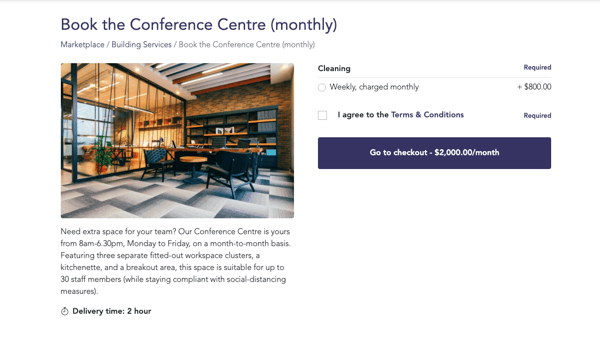Flex space technology will be a critical component of the future of the workplace. Companies will come back to offices, but many will no longer want traditional leases that lock them into set floors and pre-configured layouts. The hybrid work space is set to become more prominent.
Dror Poleg, author of Rethinking Real Estate, predicts that a more fluid dynamic will emerge in its place. ‘Space as a Service’ will become the norm. “Tenants will sign very long and expensive leases,” Poleg says, “but they will be for a needs-based bundles of services rather than a specific space.”
What are Needs-based Services?
What are these needs-based services? The list might be virtually endless. Community engagement initiatives. Fitness classes. Remote work space. Memberships. Access to communal facilities, such as gyms and conference spaces. E-commerce platforms that enable hybrid-working tenants to purchase their coffee or lunch onsite. The bigger the pool of selectable services, the better the owner offering.
Of course, transitioning a commercial asset to include a flex space model, in whole or part, is no easy task. Technological adoption was flagged by Deloitte as one of the major issues affecting CRE companies in 2021. More than half (56%) of surveyed respondents agreed or strongly agreed that the pandemic ‘revealed issues surrounding [their company’s] technology and digital transformation.’ The hardest part, understandably, is taking the first step.
How to Operate a Small Flex Space within your Asset
A good flex space transformation need not require an ‘all-in’ approach. With an affordable booking system and minimal configuration, you can turn existing common areas or unletted spaces into bookable flex spaces. Once set up, these spaces can be managed easily by your building management team with little additional effort.
By creating a small offering of spaces – be they conference rooms, hot-desks, offices, or entire sections of a floor – you can gauge the appetite for such flexibility within your existing tenant community. You can extend the trial to perspective tenants, and even the wider market. If the experiment fails, and there is little demand for your spaces, you lose only the comparatively marginal investment required to add a flex space plug-in to your workplace experience platform. The cost of doing nothing in the realm of Space as a Service, however, may be far greater.
But if your new offering proves successful, there are many potential short and long-term benefits: You might unlock new streams of revenue, open your asset up to an entirely new customer base, and build a data-backed business case for transformation on a larger scale.
Flex Space on Equiem's Tenant Experience Platform
You start with a tenant experience platform, the central point of connectivity through which your tenants access all of the products and needs-based services you offer.
Through your platform Marketplace - or through our standalone spaces booking platform - you can create and advertise bookable flex spaces of all kinds. You have control over the type of bookings you offer, and even the specific terms or arrangements attached to a given space or booking.
For example, this is a standard listing for a Conference Centre. We know, based on consultation with tenants, that overflow space is a common requirement (due to COVID-19 space restrictions). To accommodate their transient workforces, tenants in this building preferred a monthly booking arrangement, billable monthly and cancellable at any time by either party.

Within moments, and without the need for brokers or in-house leasing team members, a tenant can expand on its space as simply as adding a credit card and securely completing checkout. For building management teams, the back-end management of bookings is just as easy. Even modifiers can be added, like weekly cleaning and the addition of catering.
Why not test the waters? Reach out to us today for a demo of your flex space solution, and launch in as little as four weeks.



